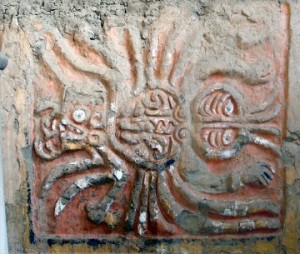 |
| The Decapitator god in the form of a spider, holding a human head in its rear legs |
The Moche culture flourished in the northwestern coastal areas of Peru around AD 100–800. Human sacrifice was a significant part of their state religion, apparently to appease a deity named Ai Apaec, who is depicted in Moche art as fanged, half-human, most often in the shape of a spider, holding in one hand a severed human head and in another the crescent-shaped ceremonial knife called a tumi. In the archeological literature, this deity has come to be called the Decapitator.
At one site, named by archeologists Huaca de la Luna, Pyramid of the Moon, and known to local shamans as El Brujo, the Sorceror, archeologists have found the remains of more than forty men, ranging in age from fifteen to thirty years old. Their bones are scattered — apparently the bodies were tossed over the edge of a stone outcrop — and embedded in thick layers of sediment, indicating they may have been sacrificed during the heavy rains of El Niño.
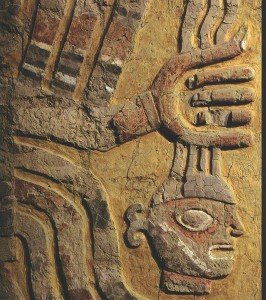 |
| Another image of the Decapitator (detail) |
There is every reason to believe these bodies were human sacrifices. The victims had cut marks on their neck vertebrae indicating their throats had been slit; several were decapitated and had their jaws removed. And the victims may have been tortured before their death. Some of the skeletons were splayed, as if they had been tied to stakes; many had their femurs forcibly torn from their pelvic sockets; ribs, skulls, and long bones bore marks of cutting. In addition, many victims had multiple healed fractures to their ribs, shoulder blades, and arms, suggesting regular participation in combat. They may thus have been the losers in ritual combat among elite Moche warriors, fighting with mace-like clubs, or, more likely, prisoners of war captured in territorial combat with other societies.
Such sacrifices are frequently depicted in Moche art, both on ceramics and on walls within the pyramid sites themselves. The sacrifice is portrayed as an elaborate blood-letting ritual in which naked bound victims — often shown, surprisingly, with erect penises — have their throats cut with a tumi, and the spurting blood caught in gold goblets to be drunk by high priests.
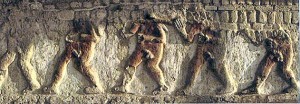 |
| Bound prisoners being led to sacrifice |
Often depicted in these sacrificial scenes is a sort of seed pod floating in the air over flying priests or bound victims marching off to be sacrificed —a grooved, comma-shaped fruit with an enlarged calyx. Because of its shape, archeologists have generally called the plant ulluchu, a Quechua term meaning penis pepper, apparently coined by pioneer Moche scholar Rafael Larco Hoyle. For more than seventy years, the identification of this plant was seen as the greatest remaining challenge in the archaeobotany of the northwest Peruvian coast.
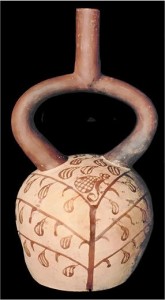 |
| Ulluchu plant with hanging pods painted on a jar |
Ethnobotanist Rainer Bussmann and anthropologist Douglas Sharon — whose work I have discussed here — have long been interested in identifying ulluchu. For years they consulted local curanderos and sellers of medicinal plants. “We would go to these markets,” Sharon has said, “and people would say, ‘We think we know what that is, but it’s not being sold here.’” The curanderos claimed to have heard of a plant called ulluchu, perhaps because of its coinage by Larco; but they did not use it, they could not describe it, and the term had no place in their language. “For the last seventy years people have been trying to identify this fruit but couldn’t,” Bussmann says. “And when our work started, I thought to myself, This is not going to be simple.”
Now, in an article in the Journal of Ethnobiology and Ethnomedicine, Bussmann and Sharon have identified ulluchu, not as a pepper, but rather as a group of species in the genus Guarea, which is in the Meliaceae or mahogany family.
Their break came when actual dried remains of the fruit were unearthed during excavation of the the tombs of Dos Cabezas in the ancient Moche city of Sipan. Armed with actual physical specimens, even though they were desiccated, Bussman eventually focused on the genus Guarea, mostly restricted to tropical lowland forests, with some species reaching cloud forest habitat. No species is found along the dry coast of Peru, which means that the plant must have been widely traded in Moche times.
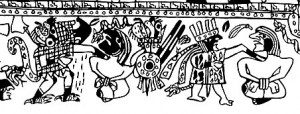 |
| Prisoners, their hands tied behind them, having their throats slit, with ulluchu floating above |
This identification required Bussmann to sort through more than a thousand possible candidates in one of the most biodiverse regions in the world, in the hope of finding a specimen that matched the archeological find. “Rainer is a first-rate taxonomist,” Sharon says. “He studied every physical characteristic of these plants until he was absolutely certain we had it.” When Bussmann compared specimens of Guarea to drawings of the ulluchu that had been unearthed a decade earlier, he knew he had found the plant.
While the existing literature on Guarea seed compounds is fragmentary, Bussmann and Sharon believe that a concentrated dosage of ulluchu seeds, if ingested, would increase heart rate, elevate blood pressure, and widen blood vessels. This would make it easier to extract sacrificial blood — and cause those surprising erections.
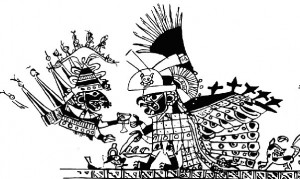 |
| Priest costumed as a bird drinking a goblet of blood, with ulluchu in a basin, and perhaps holding a snuff tube |
Bussmann and Sharon also suspect that a ground preparation of Guarea seeds, when inhaled, may have been used as a hallucinogen. One ceramic figurine shows a seated male with ulluchu plants on his headdress holding a gourd and pestle, possibly containing ground ulluchu seeds, with his nostrils flared, as is often seen in people inhaling hallucinogenic snuffs. Similarly, a fineline painting shows a winged runner or flying priest with ulluchu on his belt, ulluchu seeds floating above his head, and an instrument in his hand that closely resembles a typical double snuff tube of the sort used to inhale powdered hallucinogens. When inhaled by priests, some components could have a psychoactive effect, which would not necessarily lead to high levels of toxicity, and could induce very rapid, short-term hallucinations.

- Previous Post: Painting the Plants with Light
- Next Post: The Shulgin Documentary
- More Articles Related to: Indigenous Culture, Research Studies, Sacred Plants


